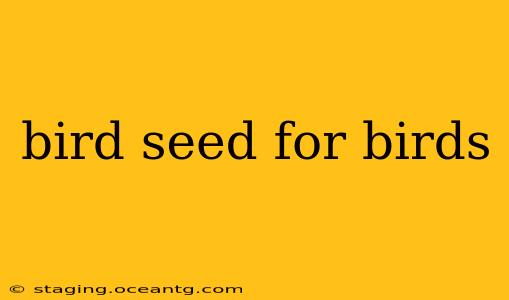Attracting birds to your backyard is a rewarding experience, offering hours of entertainment and a connection with nature. But choosing the right birdseed is crucial for attracting a diverse range of species and ensuring their health. This comprehensive guide will delve into the world of birdseed, helping you select the perfect mix for your feathered visitors.
What are the different types of birdseed?
The birdseed market offers a wide variety of options, each catering to different bird species and preferences. Understanding these differences is key to attracting the birds you want to see. Common types include:
-
Sunflower Seeds: A favorite among many birds, especially larger species like cardinals and jays. Black oil sunflower seeds are particularly popular due to their high oil content and easy shelling. Striped sunflower seeds are also a good choice, though they require a bit more effort to crack open.
-
Nyjer (Thistle) Seed: This tiny seed is a magnet for finches, goldfinches, and siskins. It's packed with nutrients and is highly appealing to these smaller birds. It's often sold in specialized feeders designed to prevent larger birds from accessing it.
-
Milo (Sorghum): A less expensive option, Milo is primarily eaten by ground-feeding birds like doves and sparrows. It's a good filler in seed mixes but may not attract the more diverse range of birds that sunflower or nyjer seeds do.
-
Cracked Corn: This is another popular choice for ground-feeding birds, especially larger species. It provides a substantial food source, especially during colder months.
-
White Proso Millet: This small seed is enjoyed by a variety of birds, including sparrows, juncos, and doves. It's a relatively inexpensive option and is often included in mixed seed blends.
What kind of birdseed should I use in winter?
Winter presents unique challenges for birds, requiring a higher-calorie diet to stay warm and energized. During colder months, consider offering:
- High-oil seeds: Black oil sunflower seeds are ideal, providing essential fats for warmth and energy.
- Suet: This high-energy food source is particularly important in harsh winter conditions. It's a type of rendered beef fat often mixed with nuts, seeds, and fruits.
- Nuts: Peanuts (in the shell or shelled) provide a valuable source of protein and fat.
What type of birdseed attracts hummingbirds?
Hummingbirds have unique dietary needs and don't consume traditional birdseed. Instead, they thrive on nectar-rich foods. You can attract hummingbirds by providing:
- Nectar feeders: These are filled with a sugar-water solution that mimics the natural nectar found in flowers. It's crucial to clean these feeders regularly to prevent mold growth.
- Flowering plants: Planting nectar-rich flowers such as bee balm, salvia, and trumpet vine will naturally attract hummingbirds to your garden.
Is it bad to feed birds bread?
Yes, feeding birds bread is generally considered bad. Bread offers little nutritional value and can even be harmful. It lacks essential nutrients and can fill a bird's stomach without providing the necessary energy. Furthermore, bread can cause digestive problems and even fungal infections.
How often should I refill my bird feeders?
The frequency of refilling your bird feeders depends on several factors, including the size of your feeders, the number of birds visiting, and the type of seed you're using. As a general rule, aim to refill your feeders when they are about half empty. This prevents birds from going hungry and also minimizes the risk of seed spoiling.
What kind of bird feeder is best?
Different bird feeders are designed to attract different species of birds. Tube feeders are popular for smaller birds like finches, while hopper feeders offer a larger capacity for mixed seed blends. Ground feeders are best for birds that prefer to forage on the ground. The best feeder for you will depend on the types of birds you want to attract and the space available in your yard. Experimenting with different feeder types may be necessary to determine which works best for your location and the local bird population.
This guide provides a solid foundation for selecting the right birdseed to enhance your birdwatching experience. Remember, offering a variety of high-quality food sources is key to attracting a diverse range of birds to your backyard, enriching your connection with nature.
